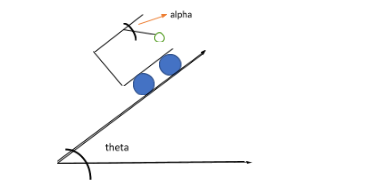
A trolly falling freely on an inclined plane as shown in the figure. The angle of string of pendulum with the ceiling of trolley is $\left( \alpha \right)$ equal to-

(A). ${\theta ^ \circ }$
(B). ${90^ \circ } - {\theta ^ \circ }$
(C). ${90^ \circ }$
(D). ${0^ \circ }$
Answer
519.2k+ views
- Hint: We will add the component of tension and component of weight and put it in the formula of force in order to solve this question. The formula for force is $F = ma$.
Complete step-by-step solution -
Let T be the tension acting on the trolley.
So, the component of tension along the inclined plane is $T\cos \alpha $.
If m is the mass of the system of trolley, then the component of weight along the inclined plane is $mg\sin \theta $.
As we know that the acceleration of the trolley is equal to the acceleration of the bob in the trolley as bob is in the equilibrium in the frame of the trolley.
So, the net force along the plane will be-
$
\Rightarrow F = ma \\
\\
\Rightarrow mg\sin \theta + T\cos \alpha = ma \\
$
For the free falling trolly on an inclined plane, acceleration $a = g\sin \theta $ along the plane.
So, putting this value of acceleration in the above formula, we get-
$
\Rightarrow mg\sin \theta + T\cos \alpha = ma \\
\\
\Rightarrow mg\sin \theta + T\cos \alpha = mg\sin \theta \\
$
Cancelling $mg\sin \theta $ from both the sides, we get-
$
\Rightarrow mg\sin \theta + T\cos \alpha = mg\sin \theta \\
\\
\Rightarrow T\cos \alpha = 0 \\
\\
\Rightarrow \cos \alpha = 0 \\
\\
\Rightarrow \alpha = {90^ \circ } \\
$
Hence, option C is the correct option.
Note: In physics, tension is depicted as the pulling force transmitted axially by the methods for a string, a cable, chain, or comparative one-dimensional continuous object, or by each finish of a bar, truss member, or comparable three-dimensional object; tension may likewise be portrayed as the action-reaction pair of forces acting at each finish of said elements.
Complete step-by-step solution -
Let T be the tension acting on the trolley.
So, the component of tension along the inclined plane is $T\cos \alpha $.
If m is the mass of the system of trolley, then the component of weight along the inclined plane is $mg\sin \theta $.
As we know that the acceleration of the trolley is equal to the acceleration of the bob in the trolley as bob is in the equilibrium in the frame of the trolley.
So, the net force along the plane will be-
$
\Rightarrow F = ma \\
\\
\Rightarrow mg\sin \theta + T\cos \alpha = ma \\
$
For the free falling trolly on an inclined plane, acceleration $a = g\sin \theta $ along the plane.
So, putting this value of acceleration in the above formula, we get-
$
\Rightarrow mg\sin \theta + T\cos \alpha = ma \\
\\
\Rightarrow mg\sin \theta + T\cos \alpha = mg\sin \theta \\
$
Cancelling $mg\sin \theta $ from both the sides, we get-
$
\Rightarrow mg\sin \theta + T\cos \alpha = mg\sin \theta \\
\\
\Rightarrow T\cos \alpha = 0 \\
\\
\Rightarrow \cos \alpha = 0 \\
\\
\Rightarrow \alpha = {90^ \circ } \\
$
Hence, option C is the correct option.
Note: In physics, tension is depicted as the pulling force transmitted axially by the methods for a string, a cable, chain, or comparative one-dimensional continuous object, or by each finish of a bar, truss member, or comparable three-dimensional object; tension may likewise be portrayed as the action-reaction pair of forces acting at each finish of said elements.
Recently Updated Pages
JEE General Topics in Chemistry Important Concepts and Tips

JEE Extractive Metallurgy Important Concepts and Tips for Exam Preparation

JEE Atomic Structure and Chemical Bonding important Concepts and Tips

JEE Amino Acids and Peptides Important Concepts and Tips for Exam Preparation

Electricity and Magnetism Explained: Key Concepts & Applications

JEE Energetics Important Concepts and Tips for Exam Preparation

Trending doubts
JEE Main 2026: Application Form Open, Exam Dates, Syllabus, Eligibility & Question Papers

Derivation of Equation of Trajectory Explained for Students

Hybridisation in Chemistry – Concept, Types & Applications

Understanding the Angle of Deviation in a Prism

How to Convert a Galvanometer into an Ammeter or Voltmeter

Degree of Dissociation: Meaning, Formula, Calculation & Uses

Other Pages
JEE Advanced Marks vs Ranks 2025: Understanding Category-wise Qualifying Marks and Previous Year Cut-offs

Thermodynamics Class 11 Physics Chapter 11 CBSE Notes - 2025-26

Units And Measurements Class 11 Physics Chapter 1 CBSE Notes - 2025-26

NCERT Solutions For Class 11 Physics Chapter 8 Mechanical Properties Of Solids

Motion in a Straight Line Class 11 Physics Chapter 2 CBSE Notes - 2025-26

Laws of Motion Class 11 Physics Chapter 4 CBSE Notes - 2025-26




